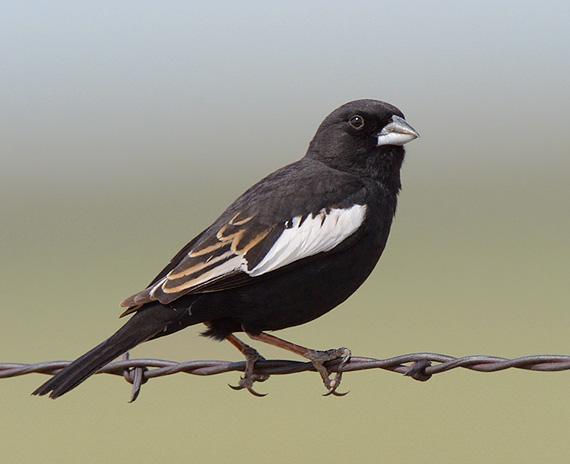State Bird
Full Article
The Lark Bunting, Calamospiza melanocoryus Stejneger, was adopted as the official state bird on April 29, 1931. The Lark Bunting is a migrant bird. Flocks arrive in April and inhabit the plains regions and areas up to 8,000 feet in elevation. They fly south again in September. The male bird is black with snowy white wing patches and edgings, tail coverts and outer tail feathers. In winter the male bird changes to a gray brown like the female bird; however, the chin remains black and the black belly feathers retain white edgings. The female bird is gray brown above and white below with dusky streaks. The male bird is six to seven inches while the female is slightly smaller. The male bird performs a spectacular courtship flight, during which he warbles and trills a distinctive mating song.
10th Grade
The Lark Bunting, Calamospiza melanocoryus Stejneger, was adopted as the official state bird on April 29, 1931. The Lark Bunting is a migrant bird. Flocks arrive in April and inhabit the plains regions and areas up to 8,000 feet in elevation. They fly south again in September. The male bird is black with snowy white wing patches and edgings, tail coverts and outer tail feathers. In winter the male bird changes to a gray brown like the female bird; however, the chin remains black and the black belly feathers retain white edgings. The female bird is gray brown above and white below with dusky streaks. The male bird is six to seven inches while the female is slightly smaller. The male bird performs a spectacular courtship flight, during which he warbles and trills a distinctive mating song.
8th Grade
The Lark Bunting, Calamospiza melanocoryus Stejneger, was adopted as the official state bird on April 29, 1931. The Lark Bunting is a migrant bird. Flocks arrive in April and inhabit the plains regions and areas up to 8,000 feet in elevation. They fly south again in September. The male bird is black with snowy white wing patches and edgings, tail coverts and outer tail feathers. In winter the male bird changes to a gray brown like the female bird; however, the chin remains black and the black belly feathers retain white edgings. The female bird is gray brown above and white below with dusky streaks. The male bird is six to seven inches while the female is slightly smaller. The male bird performs a spectacular courtship flight, during which he warbles and trills a distinctive mating song.
4th Grade
The Lark Bunting was adopted as the official state bird on April 29, 1931. The Lark Bunting is a migrant bird. Flocks arrive in April. They live the plains regions and areas up to 8,000 feet. They fly south again in September. The male bird is black with snowy white wing patches and outer tail feathers. In winter, the male bird changes to a gray brown. The chin remains black and the black belly feathers keep their white edgings. The female bird is gray brown above and white below with dusky streaks. The male bird is six to seven inches. Females are slightly smaller. The male bird performs a spectacular courtship flight. During the flight, he warbles and trills a distinctive mating song.






